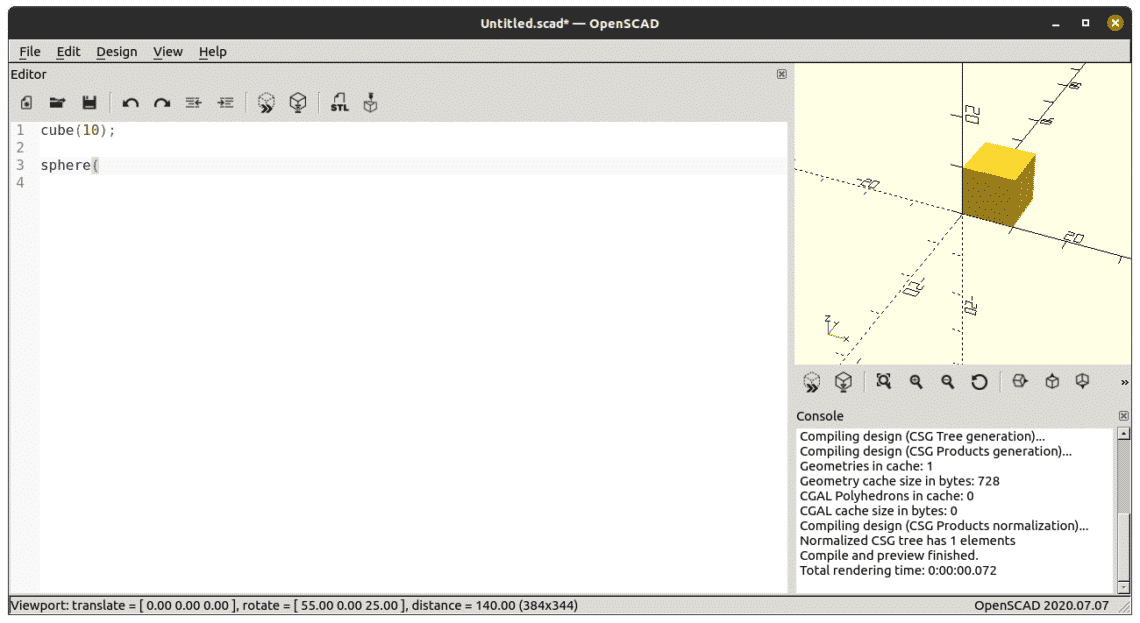
V =1.35*r // distance for placing bevel sphere
#Openscad bevel code
Here is the full, final OpenSCAD code for the Penny Trap model: Finally, in the “render” section we use difference to remove the cylinders from the rounded cube. The “ #” in front of the cylinders is only for this demo it makes the cylinders red so that we can see them even after they are removed. Each cylinder is translated to be centered and then rotated so that the three cylinders lie in mutually perpendicular directions. OpenSCAD does not like it when two objects share the same faces, so we we are making the cylinders longer so as to not have faces that coincide with the faces of the rounded cube object. We made the cylinders a little longer than the box so that they would cut out clean holes. The module cylinder_holes below makes four cylinders, each with radius equal to 70% of the radius of the coin, so that the coin cannot fall out of the holes. Our box_hull module does not take any arguments, although it does use the global radius parameter r. The parentheses in box_hull() are where we would pass an argument to the box_hull code, if one were needed. We’re making this more complicated than necessary right now, with all these variables however this will help us keep everything parametrizable for resizing later. We’ll do this by making eight small spheres (1/5 the radius of the penny), translating them around to the eight corners of a box that is a sized for the penny (a little more than 4/5 the radius of the penny), and then taking their convex hull with the OpenSCAD hull module. Also notice to avoid RADIUS IS NOT DIAMETER confusion we’ll define them both: We’ll need to use the diameter of a penny in this model, but we might as well make that a variable so that we can easily resize our model for larger and smaller coins later. Once it finishes compiling (which can take a while if you’ve set your resolution too high, so watch out), use File/Export/Export as STL to export the file. To export for 3D printing, just hit F6 instead of F5.

I recommend selecting View/Show Axes from the top menu so that you don’t get lost. Press F5 and a sphere with radius 20mm will appear in the graphics window.
#Openscad bevel for free
You can download OpenSCAD for free at Once you install the software, open up a new window and type Install OpenSCAD and learn to type, move, compile, and export. I’ll walk you though a simple example that will build up to our penny trap model. OpenSCAD is very easy to learn and you can start simply.
#Openscad bevel how to
Also it is simple to make our design parametrizable so that we can easily create traps for other larger or smaller coins (see the Customizable Coin Traps).Īt this point you may be thinking that you don’t know how to write computer programs.

Here’s what the OpenSCAD version of our Penny Traps look like notice they are more beveled and slightly fancier-looking. Unlike more difficult programs like Maya and Blender, OpenSCAD is not concerned with creating 3D models that are pretty to look at on-screen OpenSCAD focuses solely on making CAD models that you can output for 3D printing and actually making in real life. OpenSCAD is a free and easy-to-learn programming language built specifically to produce models for 3D printing. Tinkercad is a fantastic way to get started with 3D modeling, but when you’re ready to move to the next level I suggest learning OpenSCAD.


 0 kommentar(er)
0 kommentar(er)
